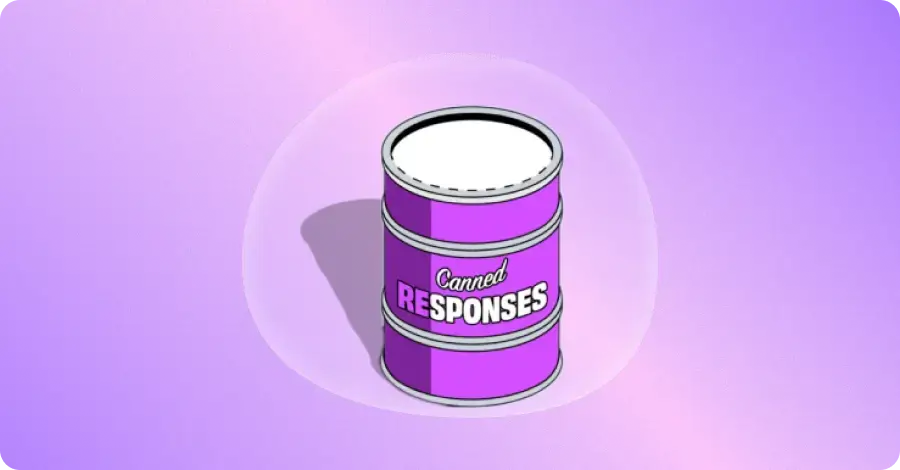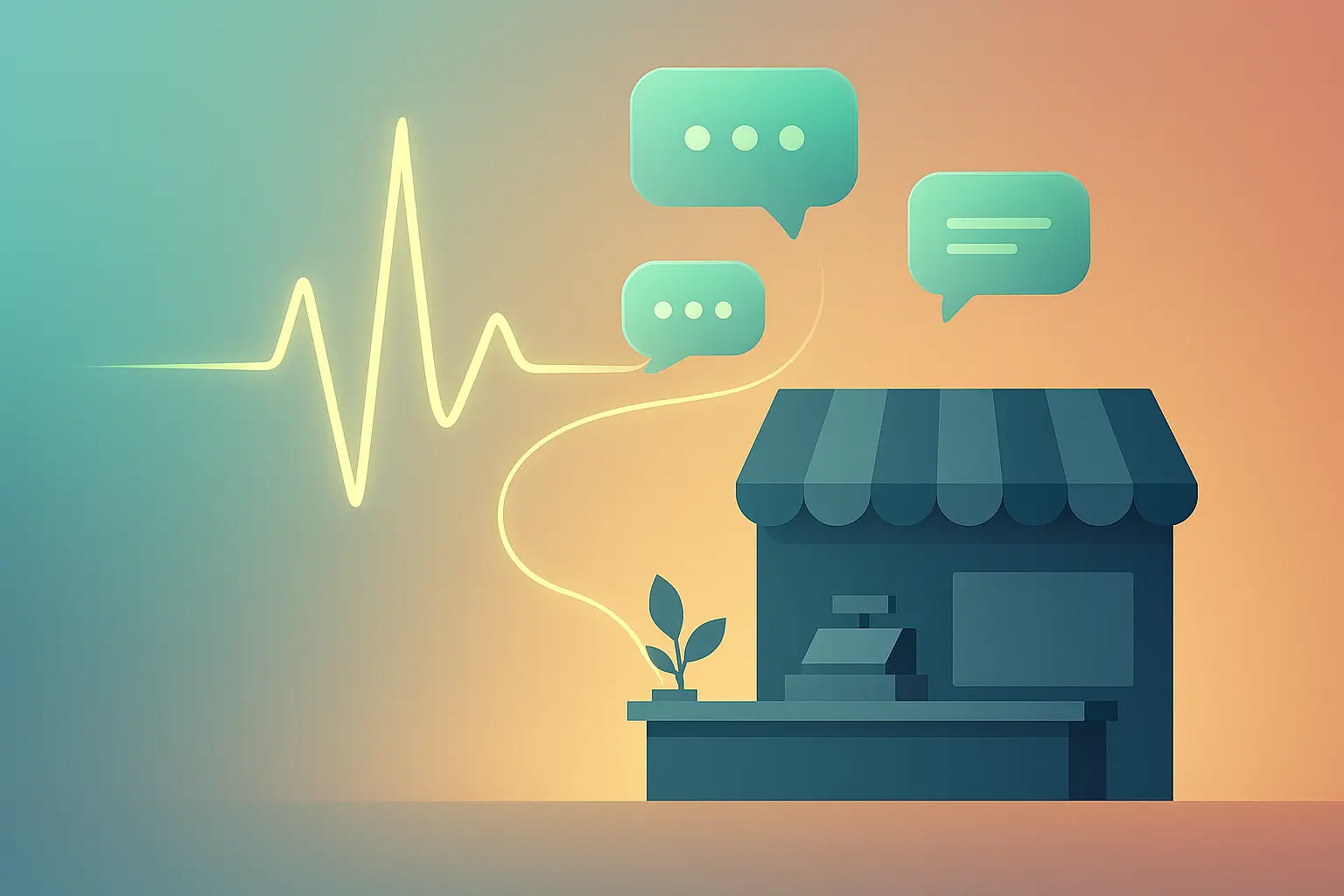25 Canned Response Examples & How to Use Them
- August 19, 2020
- 18 mins read
- Listen

What is Canned Response?
Canned responses are quick replies to common questions that you can use for customer service, sales, or marketing to boost response time. In another way, canned responses are predefined answers or messages for the frequently asked questions typically for queries related to sales, customer support, or marketing. They are used to engage customers better during an ongoing conversation to deliver a faster & consistent response.With canned replies, agents can provide personalized and accurate information promptly which makes the conversation effective. Using these responses correctly across different conversations improves agents’ productivity. These replies can be used for chats, messages, or emails to improve team key performance indicators (KPIs).Benefits of Using Canned Responses
Canned responses mean templated responses or pre-written messages. It provides significant benefits for businesses and a customer support team. Canned responses improve productivity consistency & time efficiency, reduce errors, and agents get rid of repetitive tasks. Let’s have a look at some of the major benefits of canned responses.Workflow Efficiency
Imagine cutting down on the repetitive work your team faces every day. With canned responses, that’s exactly what happens. Instead of typing out the same reply for the hundredth time, agents can quickly select a pre-written message and get back to helping more customers. It’s an easy way to save time and keep the focus on trickier issues that need more attention.Faster Response Time
Nobody likes waiting, your customers included. Email Analytics research shows that 90% of customers expect an immediate response from customer service, and 60% define “immediate” as within 10 minutes. With canned responses, your team can reply to inquiries in seconds, whether it’s through email, live chat, or social media. Quick answers mean customers aren’t left hanging, and your team gets to handle more requests in less time.Consistency
Have you ever contacted a company and gotten different answers from different agents? It’s frustrating. Canned responses eliminate that by ensuring every customer gets the same clear and professional reply, no matter who’s handling the chat.Canned responses are not just a shortcut, it is a tool that helps your team to provide service to customers more effectively.25 Best Examples of Canned Responses for Customer Support
Here is the secret, “A perfect canned response shouldn’t sound canned at all”. Canned replies should be tailored to give your customers the best experience possible. We have prepared an analysis of different scenarios across sales, support, and marketing departments. We have also added examples of best-canned messages to combat the situations.Let us discuss the scenarios and the examples of canned answers in detail that can serve your customers effectively.1. Greeting the Customers
Impressions matter and first impressions really matter. A warm, sincere greeting can create great first impressions and opportunities for memorable experiences, which will make them want to come back again.An effective greeting should help in starting up a conversation. You can prepare canned responses for different categories of different customers: visitors, returning customers, and new customers to deliver a personalized experience. Here are examples of customer service responses that can be used to greet clients.- “Hi! Good morning, how can I help you?”
- “Hey (XYZ)! Good to see you again. How may I help you today?”
2. Confirming Receipt of Inquiry
In this scenario, a customer has reached out to the company with a query or concern via email, phone, or another communication channel. The customer service representative acknowledges the receipt of the inquiry, assuring that their message has been received and will be addressed promptly.- “Thank you for reaching out to us! We’ve received your inquiry and will get back to you shortly with a solution.”
3. Acknowledging Customer’s Concern
A customer contacts the company to report a problem or express dissatisfaction with a product or service. The representative acknowledges the customer’s frustration, expresses empathy, and assures them that their concern will be addressed promptly and effectively.- “I understand your frustration and apologize for the inconvenience caused. Let’s work together to resolve this issue.”
4. Asking for More Information
Collecting information is an important part of getting work done in the right manner, but it needs to develop trust and comfort. Information can be general, credit card, billing, address verification, or personal. Acquiring all the details related to the issue helps the agent in providing the right solution to the customer. Designing canned replies that help in asking for more details to the customer queries shortens the duration of providing answers. Here are some examples of the best-canned answers that fit the above scenario.- “Great! I can surely help you. Before that, I will need some information from you. What is the order date?”
- “ Prior to providing you the right answer, I would request you to provide me your email and contact number”
5. Providing Basic Information
A customer is interested in learning more about a product or service offered by the company. The representative provides a brief overview of the product/service, highlighting its key features or benefits, and offers to provide more detailed information based on the customer’s specific needs or interests.- “Certainly! Our product/service offers [brief description]. Would you like more details on any specific aspect?”
6. Assuring Assistance
A customer expresses uncertainty or concern about resolving an issue. The representative reassures the customer that help is available and encourages them to provide more details about the problem so that appropriate assistance can be provided.- “Rest assured, we’re here to help! Could you please provide more details so we can assist you effectively?”
7. Handling Frustrating Customers
An angry customer expects you to listen and then respond. What you say (or write) can make or break the experience. What you say next is vital because when customers are asked to rate their experiences, their opinion is based on how they feel they are being treated.Actively listening to customers is the first step to handle angry customers. Do not interrupt the customer in between and let him vent. Meanwhile, you can take notes on the facts. Then acknowledge emotions, the situation, or something clearly important to the customer. Prepare canned responses that carry positive words and phrases:- “I am sorry about the trouble you faced. Let’s work together to find a solution”.
- “I can understand why you’d be upset. Please tell me more about …”
8. Expressing Availability
The customer wants to know when the company’s customer service team is available for assistance. The representative confirms the availability of support and assures the customer that help is accessible whenever needed.- “Our team is here to support you! Feel free to reach out if you need any assistance.”
9. Fixing the Problem Right Away
Customers are an asset to every business. They are the ones who use your product and provide you with insights about the white and gray areas. Hence, it is crucial to acknowledge their issues as early as possible.Promptly admitting the problem and giving an estimated time of when you are going to resolve their issue make a huge difference. It gives the feeling that they are valued and their problem is being looked into, which reduces customer churn rate. Some canned replies examples that fit perfectly to such a scenario are:- “We have examined your request and identified the problem. Our team has started working on it. It will be fixed very soon [ETA]. We will keep you updated. In the meantime, can I offer you an alternative solution or a small discount?”
- “Thank you for reporting the issue. It has been forwarded to the concerned team for a fix. It will be resolved in a day.”
10. Resolving a Ticket
When customers raise a request, they expect a faster resolution. Delivering instant response is one of the customer service tips followed by many businesses. Addressing customer queries in real-time also boosts customer satisfaction. Having canned responses helps agents to update about ticket resolution. Follow the examples mentioned below to handle such situations:- “Hi XYZ, you have reported the (issue) in the first part of the day. We are happy to inform you that it is now fixed. Thank you for reaching us with the problem, we really appreciate it.”
- “Hello XYZ, your (issue, ticket number) has been fixed successfully. For further queries feel free to contact us. We will be happy to help you.”
11. Saying ‘NO’ to Customers
While the prime goal of businesses is to assist customers to the best of their ability, there are instances when they have to say NO to them because. It could be what they are asking is not available or you don’t offer or they might be making unreasonable demands.But knowing when and how to tell a customer no is just as important as knowing why you are doing it. While it is okay to say no, it can be problematic if you don’t know how to say no to a customer. You can shape your customer expectations by creating the best-canned responses for saying NO politely. Here are some examples that you can follow:- “Hello XYZ, It’s awesome that you have decided to buy our product! We cannot wait to have you on board. As for your discount request, I’m sorry to say that we don’t offer discounts. We believe that our service offers more value for your money.”
- “Hi XYZ, I am sorry but we do not provide the (feature) that you are asking for.”
12. Apologizing to the Customers
Imagine you are a SaaS company that allows businesses to embed payment options on their website. The payment gateways will process the online transactions in the backend. If one of the payment gateway integrations stopped working unexpectedly, it would create a huge disturbance for customers who rely on that payment gateway. As a result, customers get annoyed and vent on the support team seeking immediate action. So how should you frame a perfect canned apology message?When the customer is telling about the problem, gather all the details and if needed ask questions to handle the situation. Using empathetic phrases and genuine apologies can help. Here are some examples fitting for such scenarios:- “We apologize for the inconvenience.” “Sorry for the trouble, we are looking into this matter.”
- “I am extremely sorry for the problems you’ve been facing with our product. I’m going to make sure that we get this taken care of today.”
13. Making a Refund Request
Every business has its own refund policy. Customers can raise a refund request based on the policy. If the duration for refund has exceeded, you have to explain to the customers that you can not accept the request.You should have canned responses that show your refund policy. It will provide them with the complete details for getting a refund or not. Here are some examples of canned responses that can be used for such scenarios:- “Hi XYZ, I’m unable to process your refund/return/exchange request because the product was damaged after delivery. However, it can still be fixed. Here are some tutorials (link) that might be useful.”
- “Hello XYZ, We will process your refund as per our policy and update you.”
14. Canceling Subscription
Customers request to cancel subscriptions when they find that the products or services are not meeting their business objectives. Having well-defined canned replies for such scenarios helps you handle the conversation without making the customer feel bad. You can follow the canned response examples mentioned below:- “We are really sorry that our products/services failed to meet your needs. I can cancel your subscription successfully. However, if you can mention the exact reason for cancelation, it can help us to enhance our brand.”
- “It is disappointing to hear that our product was unable to meet your purpose. Do not worry, your account subscription will be canceled. Thank you for choosing us.”
15. Collect Customer Feedback
Customer feedback, no matter positive or negative, brings new opportunities for your business. When customers share their opinions about your products/services, you should be grateful to them. They are the most reliable source of acquiring actionable feedback.Action-based feedback is highly beneficial to getting real-time insight into how customers feel, such as at the end of every conversation, after checkout, or a product demo. You need to prepare canned responses for thanking customers for providing feedback at different times across different channels. Here are some of the best-canned response examples.- “Thank you so much for your valuable feedback. We hope you continue choosing us and give us a chance to deliver you a great experience.”
- “Thank you for sharing your feedback. We are extremely sorry about your bad experience. We regret that we missed meeting your expectations. We assure you that it won’t happen again.”
16. For a Demo or Appointment Booking
A product demo or appointment booking is the most critical process of a B2B SaaS company. It is an opportunity to demonstrate the value of your product to a prospective customer. When customers make a demo booking, it is a great chance to make your prospects understand how your solution truly solves their pain points.Having canned answers for the prospects who want to book a demo or an appointment, helps in converting the opportunity and closing the contract faster. Some examples that can be followed for the demo booking scenario are:- “You can easily book a meeting through this (link).”
- “Thank you for the demo request. Follow the (link) for a detailed meeting.”
17. Request for Features
There are times when customers are not aware of all the features. They want to understand all the features that your brand offers. For such scenarios, you need to create canned responses that provide access to the support content or links that explain the features elaboratively. Some examples of canned replies are as follows:- “Thank you for showing interest in learning more about the features. You can find all of our features here (link).”
- “You can follow the (link) to understand the features in detail.”
18. Offering Alternative Solutions
The customer requests a specific feature or solution that the company does not currently offer. The representative suggests alternative options or workarounds that may meet the customer’s needs or recommends similar features that are available.- “While we don’t have that specific feature at the moment, we do offer [alternative feature] which could meet your needs. Would you like more information?”
19. Redirecting to Help Resources
The customer prefers to seek assistance through a different support channel, such as phone support or live chat. The representative provides information on alternative support options and encourages the customer to reach out through the preferred channel for immediate assistance.- “For immediate assistance, you can also check out our FAQ section here: [link]. If you still need help, feel free to reach out.”
20. Sharing Support Resources
The customer seeks guidance or assistance with a common issue or question. The representative directs the customer to self-help resources such as an online knowledge base, FAQs, or tutorial videos that can provide immediate assistance.- “Here’s a link to our knowledge base/article that might help address your concern: [link]. Let me know if you need further assistance.”
21. Offering Assistance via Another Channel
The customer’s issue requires further investigation or escalation to a specialized team. The representative assures the customer that their request has been escalated and promises a follow-up from the appropriate team member to provide further assistance or updates.- “Our phone support is available during [business hours]. You can reach us at [phone number] for immediate assistance.”
22. Waiting in Queue
A well-designed queue message sets clear expectations and does not frustrate the customers. At times, when all the agents are busy handling conversations, you can set a personalized queue message that gives an idea about the wait time for getting connected to the agent.Queue messages can be created in a way that customers know what is the queue position so that they can make a decision. Setting customer expectations and meeting them improves your brand credibility. Here are some canned response examples for queue messages.- “All our agents are engaged right now. Your position is (number) in the queue. Please wait till our support champion connects with you.”
- “Sorry! All our agents are busy at this moment. Please wait for “queue time”, while our representative will join you shortly.”
23. Transferring Request to Another Rep
Sometimes you do not have the solution to the problems asked by your customers and it is completely okay. Carrying on the conversation without accurate information won’t make it effective. But what the agent does on the spot makes the difference. The agent should politely admit that he may not be the right person who help and transfer the chat to another agent who can handle the conversation efficiently. Having such canned answers for customer service, helps both agents and customers to get the right solution at the right time. Here are some canned response examples:- “That’s an excellent question but to be honest, I may not be the right person to answer it. I am transferring to the expert for an accurate answer.”
- “I beg your pardon, I am not sure about the answer to the query. Let’s connect you to the right person and provide you with the right solution.”
24. Show Gratitude for Their Purchase
Customers deserve to be treated with respect. A customer should be thankful for being allowed to give you their hard-earned money. Since most people don’t have your product or service, they’re choosing you out of thousands of competitors. Be grateful that they even give you a chance. Use this phrase to show them gratitude;- “Thank you for your purchase. We hope you continue choosing us and give us a chance to deliver you a great experience.”
25. Expressing Availability
The customer wants to know when the company’s customer service team is available for assistance. The representative confirms the availability of support and assures the customer that help is accessible whenever needed.“Our team is here to support you! Feel free to reach out if you need any assistance.”Best Practices for Creating Canned Messages
Creating a canned response can help you avoid repetitive typing of replies during customer conversation so that you can be more efficient. However, following some tips while creating canned replies helps in making conversation effective and boosting customer satisfaction.Identify the Frequently Asked (FAQs) Categories
To create canned responses, you need to identify the requests faced frequently by sales, support, or marketing teams. It gives you clarity about the issues and you can develop the best canned messages.Make Replies as Accurate as Possible
Ensure that your pre-drafted replies should convey genuine information to the customers. Accurate answers engage customers in a better way and deliver a great experience. Eventually, they turn out to be your best brand advocates.Keep Canned Responses Short & Crisp
While designing the messages, keeping them precise and meaningful is essential. Creating canned replies to the point provides effective information that fulfills their purpose in minimal time.Personalize Your Canned Answers
Personalization adds sparkle even to the canned responses. Sending a personalized response leaves a deeper impact on customers along with instantly resolving their issues.Final Thoughts
Canned responses offer a practical solution and allow businesses to automate replies to common queries and issues. It reduces response times and ensures that communication remains consistent and professional. With the above-mentioned canned response examples, you can engage with customers by providing accurate and faster replies. Hence, canned responses can be considered an excellent tool for your sales, support, and marketing teams to improve customer satisfaction scores and increase customer retention rates.Sign upto REVE Chat and help your customers with quick replies to their queries and improve your team’s productivity.
Frequently Asked Questions
Canned responses are pre-written messages used to quickly reply to common customer inquiries, saving time and ensuring consistency.
Canned responses improve efficiency, reduce response time, ensure consistent communication, and help agents handle repetitive queries effectively.
An example of a canned phrase is, “Thank you for contacting us. How can I assist you today?”
A canned response is a single, pre-written reply used for specific questions, while a template is a more general framework or format used for creating various responses.
A canned response for customer service is a pre-composed message used by agents to address frequent customer issues, questions, or requests efficiently.




